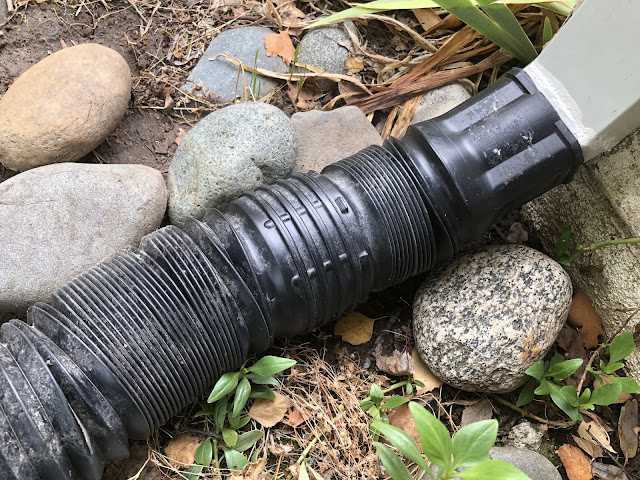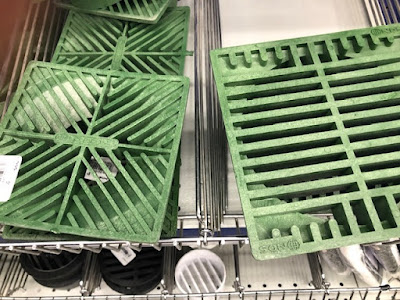
Storm revealed drainage problems; tips for how to redirect all that water

|
| The easiest way to direct runoff away from a home's foundation is with a downspout extension. But depending on the landscape, the location and the home's footprint, a more permanent drainage solution may be necessary. (Photos: Kathy Morrison) |
The aftermath of Sunday’s record rainfall was a physical reminder of a basic law of nature: Water tends to accumulate at the lowest spot. If you didn’t know where that was in your yard, you do now
So much rain after years of so little created instant lakes in landscapes that are now taking days to drain.
Where did all this water come from? Often, off your roof.
Rain gutters – in particular, the misdirection of runoff from those gutters – can lead to drainage problems. Typically, downspouts run straight down off the roof to the ground – ending close to the house and foundation. That causes water to pool around the building and potentially leak inside into basements or crawl spaces.
The solution: Extend the downspouts away from the house and foundation. Ideally, the extensions should take rainwater at least 10 feet away from the house.
If that’s not enough, a “perimeter drain” – a gravel-topped trench around the house – can help prevent water from getting into basements or crawl spaces. This drain redirects the water to a safe release point away from the foundation.
A similar technique is a “French drain” – a buried perforated pipe that collects water and directs it away from the low spot.
Despite the name, French drains have nothing to do with France. According to experts, these unusual drains were invented by an American, Henry Flagg French. He popularized them in his book on agricultural drainage, published in 1859 in Massachusetts.
Such drains can be simple to install – dig a trench, put it in – but must be strategic. (Where do you want the water to go?)

|
|
The drainage aisle of a local Ace Hardware store was looking picked-
over Tuesday, but these NDS catch-basin drain grates were still in
stock.
|
Water tends not to drain well through clay; that’s why the backyard “lake” formed in the first place. If you cover the French drain with clay soil, it plugs up the drain and doesn’t give it a chance to work.
Instead, backfill over the drain with sand, gravel, decorative rock or other fast-draining material.
Use that clay dirt to form berms to redirect rainwater away from the house and to that gravel-covered French drain.
Those berms also could form a “rain garden,” catching stormwater and allowing it to soak in where you want it – not next to the house.
Need more help? NDS, which makes a broad range of water-related products, offers tips for how to tackle drainage issues at its online Home Drainage Center. Find it here: https://www.ndspro.com/home-drainage .
Comments
0 comments have been posted.Sacramento Digs Gardening to your inbox.
Food in My Back Yard Series
April 29: What's (already) wrong with my tomato plants?
April 22: Should you stock up on fertilizer? (Yes!)
April 15: Grow culinary herbs in containers
April 8: When to plant summer vegetables
April 1: Don't be fooled by these garden myths
March 25: Fertilizer tips: How to 'feed' your vegetables for healthy growth
March 18: Time to give vegetable seedlings some more space
March 11: Ways to win the fight against weeds
March 4: Potatoes from the garden
Feb. 25: Plant a fruit tree now -- for later
Feb. 18: How to squeeze more food into less space
Feb. 11: When to plant? Consider staggering your transplants
Feb. 4: Starting in seed starting
Sites We Like
Garden Checklist for week of May 4
Enjoy this spring weather – and get gardening!
* Plant, plant, plant! It’s prime planting season in the Sacramento area. Time to set out those tomato transplants along with peppers and eggplants. Pinch off any flowers on new transplants to make them concentrate on establishing roots instead of setting premature fruit.
* Direct-seed melons, cucumbers, summer squash, corn, radishes, pumpkins and annual herbs such as basil.
* Harvest cabbage, lettuce, peas and green onions.
* In the flower garden, direct-seed sunflowers, cosmos, salvia, zinnias, marigolds, celosia and asters. (You also can transplant seedlings for many of the same flowers.)
* Plant dahlia tubers. Other perennials to set out include verbena, coreopsis, coneflower and astilbe.
* Transplant petunias, marigolds and perennial flowers such as astilbe, columbine, coneflowers, coreopsis, dahlias, rudbeckia and verbena.
* Keep an eye out for slugs, snails, earwigs and aphids that want to dine on tender new growth.
* Feed summer bloomers with a balanced fertilizer.
* For continued bloom, cut off spent flowers on roses as well as other flowering plants.
* Add mulch to the garden to maintain moisture. Mulch also cuts down on weeds. But don’t let it mound around the stems or trunks of trees or shrubs. Leave about a 6-inch to 1-foot circle to avoid crown rot or other problems.